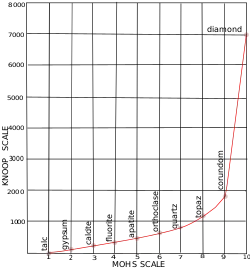Rosiwal scale
The Rosiwal scale is a hardness scale in mineralogy, with its name given in memory of the Austrian geologist August Karl Rosiwal. The Rosiwal scale bases its measure on absolute values, unlike the Mohs scale whose values are relative values, its interest is relegated to the amateur or an approach that makes it useful in the research field ('in situ').[1]
The Rosiwal method (also called Delesse and Rosiwal) is basically a method of petrographic analysis and led to the development of the stereograph.[2][1]
Rosiwal scale values
| Valor MOHS | Mineral | Rosiwal value | Chemical composition | ||||||
|---|---|---|---|---|---|---|---|---|---|
| Hardness | 1 | 10 | 100 | 1,000 | 10,000 | 100,000 | 1,000,000 | ||
| 1 | Talc | **** | Mg3Si4O10(OH)2 | ||||||
| 2 | Plaster | ***** | * | CaSO4 · 2H2O | |||||
| 3 | Calcite | ***** | ***** | CaCO3 | |||||
| 4 | Fluorite | ***** | ***** | CaF2 | |||||
| 5 | Apatite | ***** | ****** | Ca5(PO4)3(OH−,Cl−,F−) | |||||
| 6 | Feldspar | ***** | ***** | **** | KAlSi3O8 | ||||
| 7 | Quartz | ***** | ***** | ***** | * | SiO2 | |||
| 8 | Topaz | ***** | ***** | ***** | *** | Al2SiO4(OH−,F−)2 | |||
| 9 | Corundum | ***** | ***** | ***** | ***** | Al2O3 | |||
| 10 | Diamond | ***** | ***** | ***** | ***** | ***** | ***** | ** | C |
Measures in an absolute scale the hardness of minerals expressed as abrasion's resistance, measured at laboratory, starting with corundum with a base value of 1000.

Other scale
The Rosiwal scale is used in mineralogy in the same way as Mohs scale and Knoop scale.
References
Notes
- D H Maling (24 September 2013). Measurements from Maps: Principles and Methods of Cartometry. Elsevier. pp. 437–. ISBN 978-1-4832-5767-9.
- Rosiwal method
Bibliography
- The Great Encyclopedia of minerals 451 photographs, 520 pages 20'5 x 29'2 cm. Original: Artia, Prague 1986 Catalan version: Editorial Susaeta SA 1989, ISBN 978-84-30515-85-1 (printed in Czechoslovakia)
- 'Accurate mineralogy' 'De Lapparent, A .: 1965 Paris
- 'Minerals and study how to Them' 'Dana L. Hurlbut, S .: New York 1949
- 'Schöne und seltene Mineral' 'Hofmann and F. Karpinski, J .: 1980 Leipzig
- CORDUANT, William S. "The Hardness of Minerals and Rocks". Lapidary Digest c. 1990.